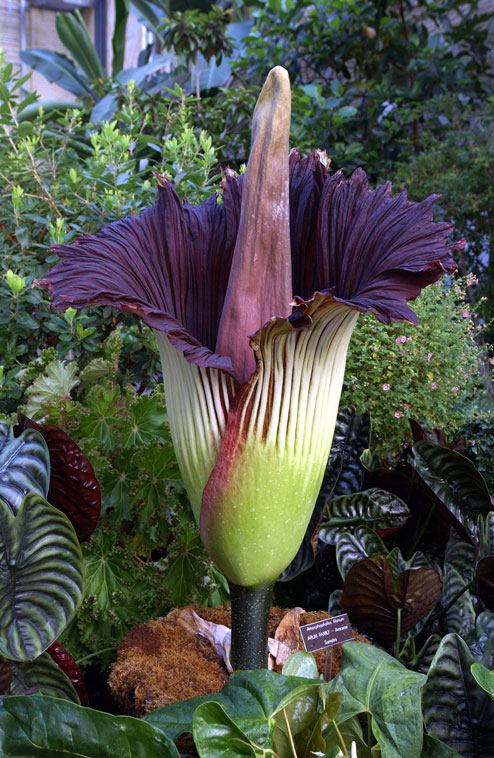Floral Scent - Part 6 (and a stinky end to this series!)
This post will be my last in the series on Floral Scent. While the previous posts have focused on describing the biochemistry of the sweet, pleasant, highly fragrant aromas of many flowers, there are a number of flowering plants that produce extremely unpleasant and foul-smelling odors. The Araceae family of angiosperms is particularly noteworthy in the latter regard. The Araceae are monocotyledons with an inflorescence called a spadix. Many species in this family are heat-producing (i.e. they are thermogenic). The heat generated by the flowers helps the flowers volatilize very stinky, putrid-smelling chemicals (resembling the stench of dead animals and/or feces (yes, this is very shitty subject indeed!)) that attract carrion-eating beetles or flies as pollinators. Excellent examples of thermogenic Araceae include: Symplocarpus foetidus (eastern skunk cabbage), Amorphophallus titanum (titan arum), Amorphophallus paeoniifolius (elephant foot yam), Helicodiceros muscivorus (dead horse arum lily), and Sauromatum venosum (voodoo lily) (Araceae - Wikipedia). An image of the titan arum is shown below:

Amorphophallus titanum (the titan arum). Image from: Amorphophallus titanum - Wikipedia
Amorphophallus titanum has the largest unbranched inflorescence in the world, reaching over 10 feet in height!
Early studies (Smith and Meeuse (1966)) revealed that Saromatum guttatum and various other Araceae produced a number of volatile amines that contribute to the rotten smell of their scent, including ammonia, methylamine dimethylamine and trimethylamine (compounds that smell like rotting fish), cadaverine (the smell of cadavers), and putrescine (a putrid smelling compound).
Saromatum guttatum also produces a number of terpenoids that do not contribute to the fetid odor, including alpha-copaene, B-caryophyllene, and alpha-caryophellene (Skubatz et al. (1995)).
The dead horse arum, Helicodiceros muscivorus, is a conspicuous, foul smelling and thermogenic plant of the Araceae family that produces oligosulphides, dimethyl mono-, di- and trisulphide and attracts flies (Stensmyr et al. (2002), Angioy et al. (2004)). Similarly the titan arum (Amorphophallus titanum) has been shown to produce dimethyl trisulfide, a compound with a sulfury odor that has been found to be emitted from some rotting vegetables, microorganisms, and cancerous wounds (Shirasu et al. (2010)). While dimethyl trisulfide seems to be the main component of the titan arum's putrid odor, there are additional contributions from trimethylamine (rotten fish smell), and isovaleric acid (smell of sweaty feet)!
However, not all species of the Araceae emit foul odors! Milet-Pinheiro et al. (2017) have more recently examined the floral scent chemistry of Xanthosoma species of the Araceae. These species typically have night-blooming inflorescences and emit strong, pleasant floral scents, presumably involved in the attraction of pollinators. "A total of 76 volatile organic compounds (VOCs), mainly terpenes and benzenoids, were detected. Floral scent bouquets diverge considerably among analyzed species of Xanthosoma mainly due to the presence of unique prominent compounds." (Milet-Pinheiro et al. (2017)).
Thermogenesis is the main mechanism for release of the dreadful odors from species such as Symplocarpus foetidus (eastern skunk cabbage), Amorphophallus titanum (titan arum), Amorphophallus paeoniifolius (elephant foot yam), Helicodiceros muscivorus (dead horse arum lily), and Sauromatum venosum (voodoo lily).
Thermogenesis raises the temperature of the spadix by over 34 degrees Celcius in many species, and has been extensively studied by thermography (see e.g. Skubatz et al. (1991), Wagner et al. (2008), Seymour et al. (2009), Korotkova and Barthlott (2009), Ito-Inaba et al. (2012)).
The biochemical mechanism for thermogenesis in the Araceae appears to involve increased expression and/or activation of an alternative oxidase (AOX) in the mitochondria. Unlike the normal terminal oxidase involved in the respiratory electron transport chain in animals and plants that is cyanide-sensitive, the alternative oxidase is cyanide-insensitive. Instead of releasing energy from electrons over several discrete steps via the terminal oxidase pathway (energy normally captured by ATP-formation via development of a proton gradient), the alternative oxidase releases energy in a single step, mostly as heat:

Alternative oxidase (AOX). Image from: Alternative oxidase - Wikipedia
AOX is induced by the plant hormone, salicylic acid, which can be mimicked by aspirin (acetyl-salicylic acid) ((Rhoads and Mclntosh (1992), Raskin et al. (1989), Ito et al. (2011), Kakizaki et al. (2011)).
An NAD(P) reductase like protein has been identified as the salicylic acid receptor in the appendix of the Sauromatum guttatum inflorescence (Skubatz et al. (2013)).
Transcriptome analysis is now beginning to shed new light on the molecular components regulating thermogenesis and floral scent production in these fascinating plant species (de Souza Cândido et al.(2014), Onda et al. (2015)).
This post is the conclusion of the series on Floral Scent: Part 1, Part 2, Part 3, Part 4, and Part 5.
Please feel free to comment or ask questions about this post in the comments section below. I will try to answer questions as soon as possible.
Hello, I just wanted to let you know that your post might have received a steemstem vote, unfortunately some of the images in your post appear to be protected by copyright, if you can fix that, please reply to this comment and I will come back to curate your post
I am very sorry about this. I was not aware that the images I used were copyrighted. The image on thermography was from:
Free Access
The gene expression landscape of thermogenic skunk cabbage suggests critical roles for mitochondrial and vacuolar metabolic pathways in the regulation of thermogenesis
YASUKO ITO‐INABA YAMATO HIDA HIDEO MATSUMURA HIROMI MASUKO FUMIKO YAZU RYOHEI TERAUCHI MASAO WATANABE TAKEHITO INABA
First published: 29 September 2011
https://onlinelibrary.wiley.com/doi/full/10.1111/j.1365-3040.2011.02435.x
Because this said "Free Access" and I cited it, I included that image in the first draft. However, it has now been removed in case that was the one responsible?
I substituted the image on alternative oxidase (AOX) with an image from Wikipedia.
Thank you, even if an article is free access sometimes its content is restricted. Some journals allow to request permissions to share images from their articles with a simple form (it literally takes 30 seconds to fill). But thanks for taking care of the images.
Thanks, I shall keep that in mind for the future. I greatly appreciate your advice.
Great post! Strangely relevant, as my boyfriend just told me Amorphophallus titanum is his favorite flower (always rooting for the underdog). Glad to learn more about it. I wonder what the evolutionary benefit is of smelling like rotting vegetables and stinky feet.
The evolutionary benefit of these foul smells seems to be for the flower to attract flies that would normally lay their eggs on rotting animal (or plant) tissues. Some flies are attracted to dead animals and others to rotting vegetable matter. The titan arum essentially tricks the flies into thinking that they are visiting a corpse or rotting vegetable matter. During their visits to the titan arum flower the flies are laden with pollen which the flies can then transfer to other flowers, achieving cross-pollination and sexual reproduction for the titan arum. The "sweaty feet" smell is just one part of a complex mixture of stinky odors which resemble those emitted by dead animals.